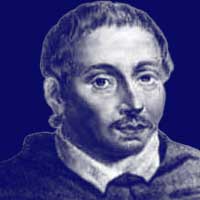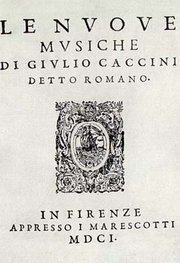Giulio Caccini Biography - A Very Quick Guide
Giulio Caccini (c.1545 – December 10, 1618) was an Italian composer, teacher, singer, instrumentalist and writer of the very late Renaissance and early Baroque eras. He was one of the founders of the genre of opera, and one of the single most influential creators of the new Baroque style. He was also the father of the composer Francesca Caccini.
| Contents |
Life
Little is known about his early life, but he was born either in Rome or Tivoli, and may have been related to the Florentine sculptor Giovanni Caccini. While in Rome he studied the lute, the viol and the harp, and began to acquire a reputation as a singer. In the 1560s, Cosimo de' Medici was so impressed with his talent that he took the young Caccini to Florence for further study.
By 1579, Caccini was singing at the Medici court. He was a tenor, and he was able to accompany himself on the viol; he sang at various entertainments, including weddings and affairs of state, and took part in the sumptuous intermedi of the time, the elaborate musical, dramatic, visual spectacles which were one of the precursors of opera. Also during this time he took part in the movement of humanists, writers, musicians and scholars of the ancient world who formed the Florentine Camerata, the group which gathered at the home of Count Giovanni de' Bardi, and which was dedicated to recovering the supposed lost glory of ancient Greek dramatic music. With Caccini's abilities as a singer, instrumentalist, and composer added to the mix of intellects and talents, the Camerata developed the concept of monody—an emotionally affective solo vocal line, accompanied by relatively simple chordal harmony on one or more instruments—which was a revolutionary departure from the polyphonic practice of the late Renaissance.
In the last two decades of the 16th century Caccini continued his activities as a singer, teacher and composer. His influence as a teacher has perhaps been underestimated, since he trained dozens of musicians to sing in the new style, including the castrato Giovanni Gualberto Magli, who sang the title role in Monteverdi's first opera Orfeo.
Caccini made at least one further trip to Rome, in 1592, as the secretary to Count Bardi. According to his own writings, his music and singing met with an enthusiastic response. However, Rome, the home of Palestrina and the Roman School, was musically conservative, and music following Caccini's stylistic lead was relatively rare there until after 1600.
Caccini's character seems to have been less than perfectly honorable, as he was frequently motivated by envy and jealousy, not only in his professional life but for personal advancement with the Medici. On one occasion, he informed to the Grand Duke Francesco on two lovers in the Medici household—Eleonora, the wife of Pietro de' Medici, who was having an illicit affair with Bernardino Antinori—and his informing led directly to Eleonora's murder by Pietro. His rivalry with both Emilio de' Cavalieri and Jacopo Peri seems to have been intense: he may have been the one who arranged for Cavalieri to be removed from his post as director of festivities for the wedding of Henry IV of France and Maria de' Medici in 1600 (an event which caused Cavalieri to leave Florence in fury), and he also seems to have rushed his own opera Euridice into print before Peri's opera on the same subject could be published, while simultaneously ordering his group of singers to have nothing to do with Peri's production.
After 1605 Caccini was less influential, though he continued to take part in composition and performance of sacred polychoral music. He died in Florence, and is buried in the church of Ss Annunziata.
Music and influence
The stile recitativo, as the newly created style of monody was called, proved to be popular not only in Florence, but elsewhere in Italy. Florence and Venice were the two most progressive musical centers in Europe at the end of the 16th century, and the combination of musical innovations from each place resulted in the development of what came to be known as the Baroque style. Caccini's achievement was to create a type of direct musical expression, as easily understood as speech, which later developed into the operatic recitative, and which influenced numerous other stylistic and textural elements in Baroque music.
Caccini's most influential work was a collection of madrigals and songs for solo voice and basso continuo, published in 1601, called Le nuove musiche. The introduction to this volume is probably the most clearly written description of the purpose, intent and correct performance of monody from the time. It includes musical examples of ornaments—for example how a specific passage can be ornamented in several different ways, according to the precise emotion that the singer wishes to convey; it also includes effusive praise for the style which he himself invented, and amusing disdain for the work of more conservative composers of the period.
Works
Caccini wrote three operas—Euridice (1600), Il rapimento di Cefalo (1600), and Euridice (1602), though the first two included music by others (mainly Peri for the first Euridice). In addition he wrote the music for one intermedio (Io che dal ciel cader farei la luna) (1589); and he published two collections of songs and madrigals, both titled Le nuove musiche, in 1601 and 1614. Most of the madrigals are through-composed and contain little repetition; some of the songs, however, are strophic. No music for multiple voices survives, even though the records from Florence indicate he was involved with polychoral music around 1610; at any rate such a manner of expression would have been alien to him. He was predominantly a composer of solo song, and it is in this capacity that he acquired his immense fame.
References
- Article 'Giulio Caccini', in The New Grove Dictionary of Music and Musicians, ed. Stanley Sadie. 20 vol. London, Macmillan Publishers Ltd., 1980. ISBN 1561591742
- Gustave Reese, Music in the Renaissance. New York, W.W. Norton & Co., 1954. ISBN 0393095304
- Manfred Bukofzer, Music in the Baroque Era. New York, W.W. Norton & Co., 1947. ISBN 0393097455
- Giulio Caccini, Le nuove musiche, tr. John Playford and Oliver Strunck, in Source Readings in Music History. New York, W.W. Norton & Co., 1950.
Top Pieces on 8notes by Giulio Caccini

